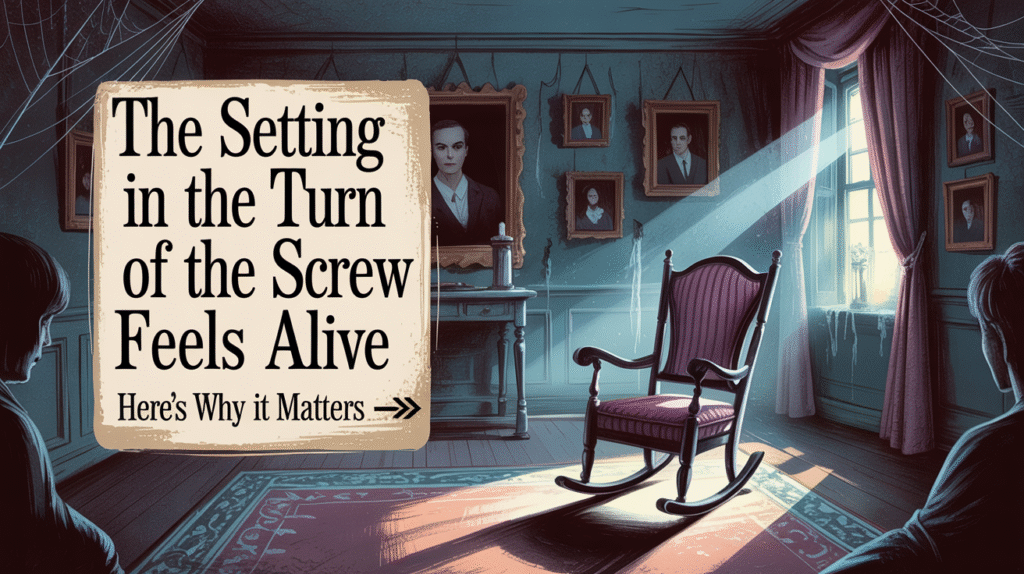The setting in “The Turn of the Screw” doesn’t just house the story, it behaves like a character, influencing emotions, controlling tension, and shaping every decision the characters make.

Henry James crafted Bly, the English country estate at the heart of The Turn of the Screw, with eerie precision. Far more than a backdrop, the setting guides the narrative with its mood, structure, and isolation. Its hallways, gardens, and rooms aren’t just spaces—they reflect the characters’ inner states and fuel the gothic terror that permeates the novel. Let’s explore how this location behaves like a living, breathing character and why that choice is essential to the novella’s psychological power.
Bly as a Mirror of the Mind
The house reflects the shifting emotional and psychological states of the governess and other characters.
Isolation as a Catalyst
Bly is cut off from society, which allows paranoia and fantasy to flourish.
- The estate’s remoteness strips the governess of external support or perspective.
- Emotional tensions build in the vacuum, as no outsider challenges her claims or beliefs.
Architecture and Interior Space
The physical structure mirrors the psychological maze the characters inhabit.
- Long corridors, sealed rooms, and unused spaces symbolize buried secrets and mental repression.
- The layout of the house creates opportunities for hidden movement, surveillance, and fear.
Gardens, Lake, and Natural Spaces
The outdoors at Bly contrasts with the haunted feel of its interior, but even these natural elements carry symbolic weight.
Illusions of Safety
The gardens and lake initially seem peaceful, offering the children places to play.
- These open areas suggest freedom, yet danger often emerges from them—ghost sightings, suspicious behavior, and arguments.
- The lake, in particular, symbolizes emotional depth and the unknown.
Nature vs. Corruption
Even nature at Bly isn’t free from contamination.
- Miss Jessel’s ghost is first seen near the lake, linking the natural world to trauma and death.
- Flora’s association with the garden diminishes as the story darkens, indicating a loss of innocence.
The Role of Light and Darkness in the Setting
Lighting at Bly plays a subtle but powerful role in establishing mood and shaping perceptions.
Daylight Deception
Even scenes in daylight carry a sense of dread.
- The estate looks beautiful and serene, but the calmness feels artificial.
- Ghostly encounters and intense emotions often strike during the day, subverting expectations.
Shadows and Candlelight
The dim interiors suggest the uncertain boundaries between reality and imagination.
- The governess frequently roams the house by candlelight, emphasizing her solitary struggle for clarity.
- Rooms partially lit or engulfed in darkness represent both literal and emotional blindness.
How Setting Controls Character Behavior
Bly doesn’t just influence atmosphere—it controls how characters act and respond to events.
Governess’s Growing Paranoia
The governess becomes more anxious and obsessive within Bly’s enclosed space.
- The setting becomes her entire world, magnifying every interaction and suspicion.
- She develops an almost spiritual connection to the estate, believing she alone can protect it.
Children’s Behavior and Space
Where the children are allowed—or forbidden—to go affects their characterization.
- The governess restricts their movements more as the story progresses.
- Forbidden zones, like the tower or the lake, become central to the plot’s escalation.
Bly as a Gothic Device
Gothic literature often uses setting as a character, and Bly is a textbook example.
Architectural Decay and Ghosts
While Bly isn’t in physical ruin, its symbolic decay is evident.
- The presence of ghosts and emotional unraveling stand in for crumbling walls or broken staircases.
- Emotional decay at Bly replaces structural ruin as the marker of a haunted space.
The House as a Trap
Characters can’t easily leave the estate, and those who do, like Flora, often suffer afterward.
- Bly is both sanctuary and prison—safe from the outside world but dangerous within.
- This duality heightens the feeling of helplessness that defines the narrative.
FAQs About the Setting in The Turn of the Screw
Here are some questions and answers about the role of setting in The Turn of the Screw:
Why is Bly considered a character in the novel?
Because it actively shapes the emotions, perceptions, and behaviors of the characters. Its mood shifts with the plot, much like a human presence.
How does the setting affect the governess?
It isolates her from the world, intensifies her paranoia, and reinforces her belief in her own interpretations without external input.
Is the estate haunted or symbolic?
It may be both. Bly could be physically haunted, but it also symbolizes emotional and mental entrapment, especially for the governess.
What’s the significance of the lake and gardens?
They suggest innocence and freedom but are ultimately tied to trauma, secrecy, and loss of control.
Why is light used symbolically in the setting?
Light represents a fragile grasp on truth. Daylight brings no comfort, and darkness heightens the psychological horror rather than concealing it.
In The Turn of the Screw, the setting is not just where the story happens—it is the story. Bly’s influence runs deep, shaping events, magnifying fears, and echoing the mental unraveling of its characters. That’s why the house doesn’t just haunt—it acts, making it one of literature’s most chillingly effective settings.
